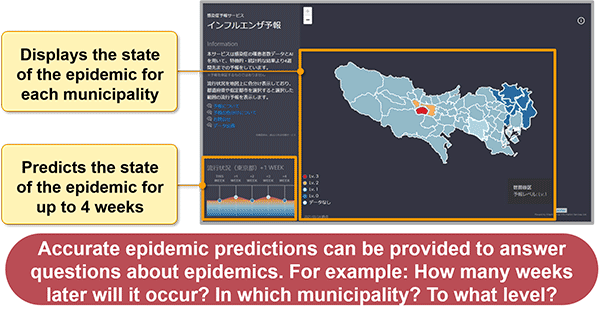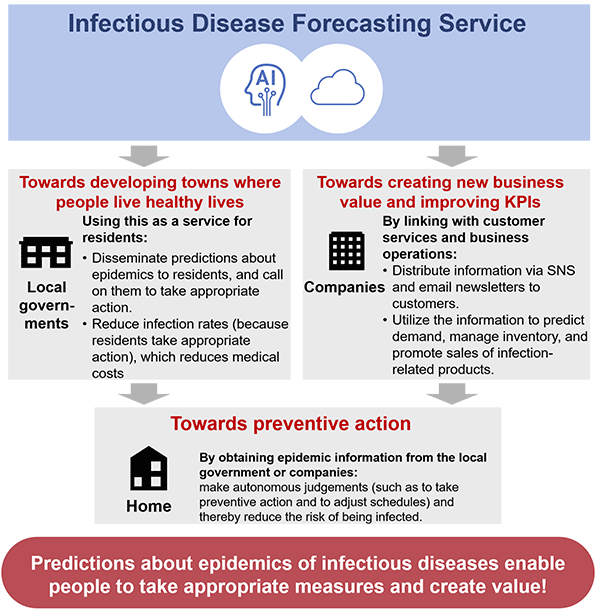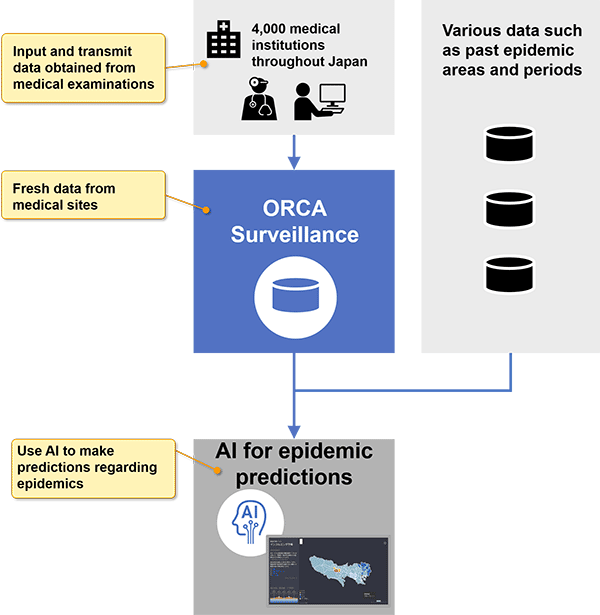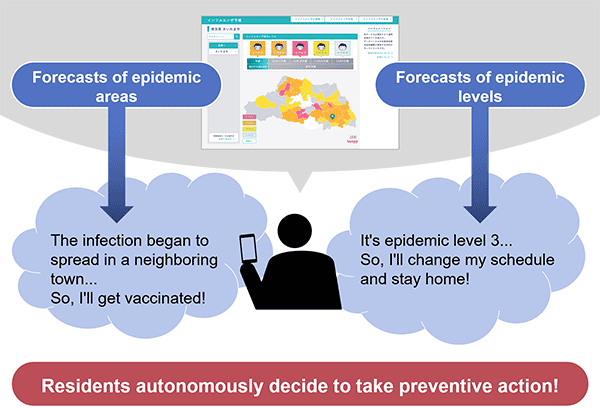Featured customer case
Lumada customer case code: UC-01673S
Infectious Disease Forecasting Service using AI
2021-07-30

Together with a variety of partners, the Hitachi Group aims to create a society where everyone can live with comfort, safety and security, and good health. This article introduces the Infectious Disease Forecasting Service, which uses AI. The service is one of the Lumada initiatives, which propose ways to create new value from collaborative creation with customers.
By using AI to analyze the data on the number of affected individuals from each medical institute, we can make predictions related to epidemics. We can then encourage residents to change their behavior and local governments and companies to take effective measures. For example, by linking the data with services and business operations of a company, the demand for infection-related products can be predicted, which helps the company to improve their KPIs (key performance indicators).
Collaborative creation with Lumada! Helping residents make autonomous judgments
In the midst of influenza-like epidemics, appropriate measures must be taken in accordance with ever-changing circumstances. In the 2009 worldwide outbreak of a new influenza strain, many local governments and companies came under pressure to implement measures even as the outbreak began to end.
An influenza epidemic can negatively impact society and the economy to the level of hundreds of billions of yen.
Negative impacts on the economy caused by influenza

To respond appropriately in accordance with ever-changing circumstances, we need accurate and detailed information. If we could know the status of an epidemic in neighboring areas in real time and could make predictions about the course of the epidemic, we could take appropriate measures in advance.
In the past, doctors in the field predicted epidemics based on data such as the number of affected individuals collected at each medical institution and their own experience. However, it was difficult for ordinary residents to find out such predictive information. Also, publicly available information on infection trends was collected some time ago, and the ability to understand the current status of an epidemic in neighboring areas was limited.
One Lumada solution is the Infectious Disease Forecasting Service, which provides views for each region in four levels, so that residents can intuitively understand the status of an epidemic. The service also provides accurate, detailed predictions about the epidemic, and answers questions such as the following up to four weeks in advance: How many weeks later will the epidemic occur? In which municipality will it occur? To what level will it occur?

* The screenshot shows an example of a display of the prediction results.
By knowing the state of the epidemic in neighboring areas and knowing predictions about the epidemic, we can take appropriate measures to reduce the negative impact on the economy caused by an influenza epidemic and identify the positive value from predictions regarding the influenza epidemic.

Utilizing data collected from medical sites
The Infectious Disease Forecasting Service provides predictions on infectious diseases for up to four weeks in advance for each municipality. The predictions are based on various types of data (including the number of affected individuals collected at medical sites) that is analyzed by an AI that issues the predictions.
The Infectious Disease Forecasting Service uses “ORCA Surveillance”*1 to provide accurate predictions about epidemics.
The ORCA Surveillance system collects fresh and valuable data, which is input and transmitted every day at medical sites. Epidemics can now be predicted by combining this real time data for the number of infected individuals collected at the medical sites and various data such as past epidemic areas and periods, and then using an AI to analyze the data.

* The screenshot shows an example of a display of the prediction results.
On December 6, 2019, Saitama city started a demonstration experiment of the “Influenza Forecasting Service of Saitama City.” This service predicts the state of influenza epidemics in Saitama city and disseminates the information. This was the first time in Japan that a demonstration experiment was carried out for forecasts of infections such as influenza at a local government level.
The demonstration experiment provided the real time status of an epidemic in Saitama city, and made predictions regarded the state of the influenza epidemic for up to four weeks in advance. The severity of the epidemic was classified into four levels. The following benefits were observed.

The ORCA Surveillance system also stores data on the number of infected individuals for infections other than influenza. In addition to this data, if we can accumulate information that might affect the number of infected individuals and the infectious disease, we can apply the Infectious Disease Forecasting Service system to other infectious diseases.
Currently, we are accelerating development with a view to applying the service to emerging diseases such as COVID-19.
For details on the solution, see the following:
For details on the development story, see the following:
By using AI to analyze data on the number of infected individuals from each medical institute, we can make predictions about epidemics and encourage residents to change their behavior and encourage local governments and companies to take effective measures. For example, by linking the data with the services and business operations of a company, we can predict the demand for infection-related products and can help the company improve their KPIs.